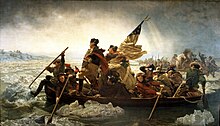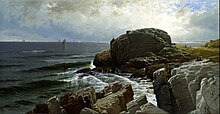Marblehead, Massachusetts
Marblehead is a coastal New England town in Essex County, Massachusetts, United States, along the North Shore.
Marblehead Harbor, protected by shallow shoals and rocks from the open sea, lies between the mainland and the Neck.
A town with roots in commercial fishing and yachting, Marblehead was a major shipyard and is often referred to as the birthplace of the American Navy, a title sometimes disputed with nearby Beverly.
A center of recreational boating, Marblehead has long been a popular sailing, kayaking and fishing destination, with several yacht clubs established in the late 19th century.
Numerous shell mounds and burial sites have been found throughout the town's history, along with foundations of multiple villages and forts.
[4] On September 16, 1684, heirs of Nanepashemet sold their 3,700 acres (15 km2); the deed is preserved today at Abbot Hall in the town.
Marblehead's first European settler was Joseph Doliber or John Peach (highly disputed) in 1629, who set up on the shore near what is now the end of Bradlee Road.
Three years earlier, Isaac Allerton, a Pilgrim from the Mayflower, had arrived in the area and established a fishing village at Marblehead Little Harbor.
In May 1635, the General Court of Massachusetts Bay established the town of Marblehead on land that belonged to Salem.
Marblehead residents, who never saw eye-to-eye with their more devout and conservative neighbors, were delighted, but less than a year later, the lawmakers reversed themselves.
The town peaked economically just before the American Revolution, as locally financed privateering vessels sought bounty from large European ships.
A large percentage of residents became involved early in the Revolutionary War, and the sailors of Marblehead are generally recognized by scholars as forerunners of the United States Navy[citation needed].
The first vessel commissioned for the army, Hannah, was equipped with cannons, rope, provisions (including the indigenous molasses/sea water cookie known as "Joe Frogger" ), and a crew from Marblehead.
The community lost a substantial portion of its population and economy, although it was still the tenth-largest inhabited location in the United States at the first census, in 1790.
[9] When George Washington visited the town during his presidential tour of 1789, he knew the sailors of Marblehead well; they had served him honorably in the war.
"[10] In the 75 years from the American Revolution to the middle of the nineteenth century, Marblehead experienced a golden age of fishing.
[11] After the war, and later into the 19th century, wealthier citizens wanted a new bank to finance vessels, and to serve the town's fishermen and merchants.
[12] The town's fishermen had 98 vessels (95 of which exceeded 50 tons) putting to sea in 1837, where they often harvested fish off the Grand Banks of Newfoundland.
[13] A Grand Army of the Republic veterans organization was formed after the war, and established headquarters in the old town house, where it still displays artifacts from the Marblehead regiments that served.
This also caused numerous "summer homes" of wealthy Boston residents to be built on Marblehead Neck.
[15] After World War II, the town enjoyed a population boom, developing as a bedroom community for nearby Boston, Lynn, and Salem.
The town consists of a rocky peninsula that extends into the bay, with an additional neck to the east connected by a long sandbar, now a causeway.
Fountain Park and Fort Sewall are located at the western edge of the mouth of Marblehead Harbor.
The town land also includes several small islands in Massachusetts Bay and Dolliber Cove, the area between Peaches Point and Fort Sewall.
It was written by the Reverend Marcia Martin Selman to the music of the hymn tune "The Lily of the Valley", from a melody by J. R. Murray, "Songs of Rejoicing", 1888.























